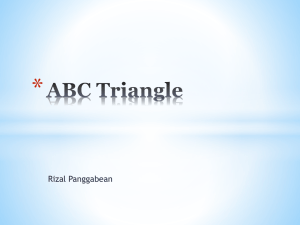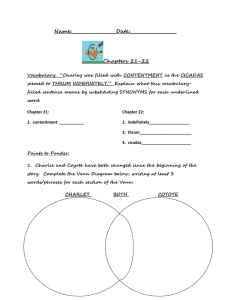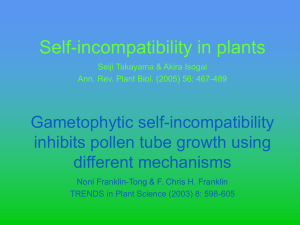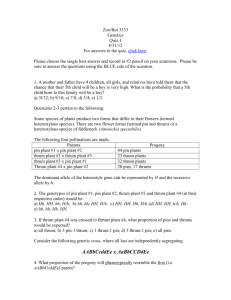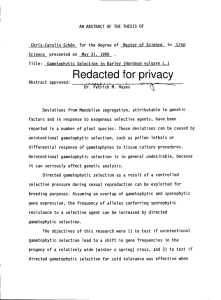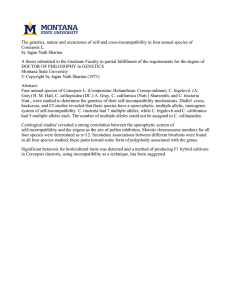SELF-INCOMPATIBILITY General references: Books- by de Nettancourt 2001; Williams et... Definition: “The inability of fertile hermaphrodite seed plants to...
advertisement
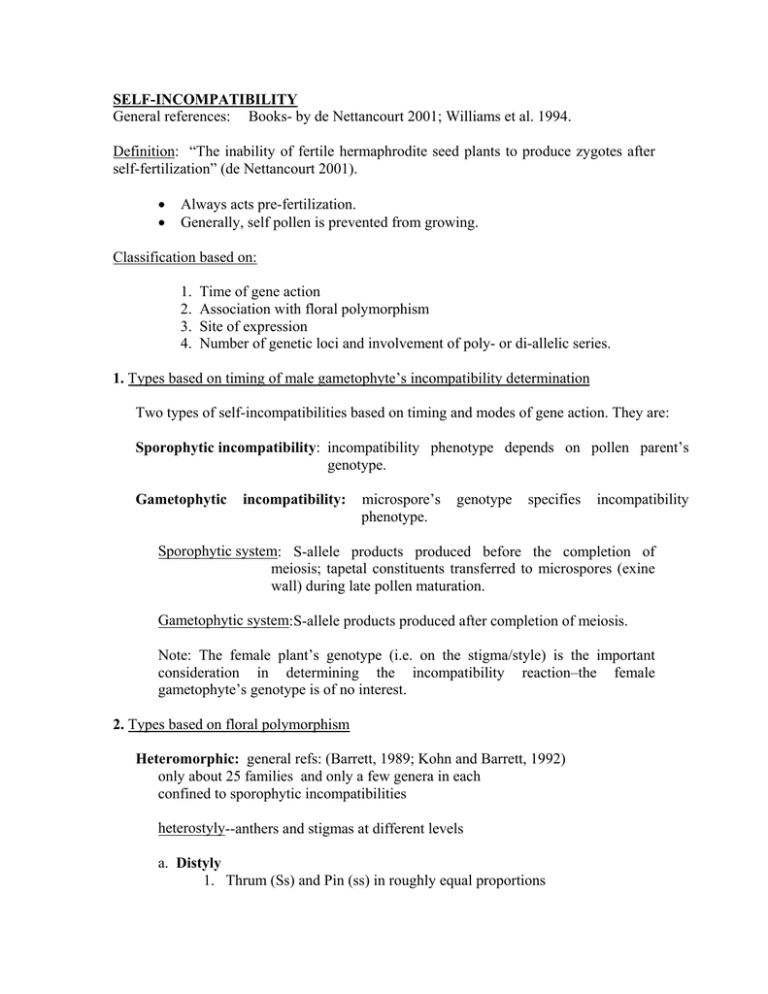
SELF-INCOMPATIBILITY General references: Books- by de Nettancourt 2001; Williams et al. 1994. Definition: “The inability of fertile hermaphrodite seed plants to produce zygotes after self-fertilization” (de Nettancourt 2001). • • Always acts pre-fertilization. Generally, self pollen is prevented from growing. Classification based on: 1. 2. 3. 4. Time of gene action Association with floral polymorphism Site of expression Number of genetic loci and involvement of poly- or di-allelic series. 1. Types based on timing of male gametophyte’s incompatibility determination Two types of self-incompatibilities based on timing and modes of gene action. They are: Sporophytic incompatibility: incompatibility phenotype depends on pollen parent’s genotype. Gametophytic incompatibility: microspore’s phenotype. genotype specifies incompatibility Sporophytic system: S-allele products produced before the completion of meiosis; tapetal constituents transferred to microspores (exine wall) during late pollen maturation. Gametophytic system: S-allele products produced after completion of meiosis. Note: The female plant’s genotype (i.e. on the stigma/style) is the important consideration in determining the incompatibility reaction–the female gametophyte’s genotype is of no interest. 2. Types based on floral polymorphism Heteromorphic: general refs: (Barrett, 1989; Kohn and Barrett, 1992) only about 25 families and only a few genera in each confined to sporophytic incompatibilities heterostyly--anthers and stigmas at different levels a. Distyly 1. Thrum (Ss) and Pin (ss) in roughly equal proportions Male sterility – classification 2 2. Only thrum x pin crosses (and reciprocal) are possible: Pin x Pin or Thrum x Thrum aren’t. pin x thrum or thrum x pin gives 1:1 segregation:: short styles and high anther: long styles and low anthers. 3. Incompatibility between pin and pin or thrum and thrum plants is governed by one dominant allele, S (not obtainable in homozygous condition), only found in trum plants. Recessive allele, s, is found in homozygous condition pin plant. b. Tristyly 1. Three stylar length, and two levels of anthers in each flower. 2. Sporophytic, two different sets of anthers in each flower-two types of pollens phenotypically, but carry same genotype. 3. Anthers and styles of similar levels are cross-compatible. 4. More complex; two loci, S and M each with a dominant and a recessive allele. S is epistatic to M/m three phenotypes. Long style ss mm; medium ss M-; short S-M- or S-mm. No reciprocal differences - both cases, reciprocal crosses give same progeny phenotype and genotype. Homomorphic: most self-incompatible systems are homomorphic –no heterostylisms-widely distributed (in about 50% of angiosperm families). 3. Site of expression Stigmatic inhibition (Sporophytic species) 1. Site of inhibition for trinucleate pollen species (e.g. Brassicaceae). 2. Exine wall holds incompatibility proteins which are immediately recognized by stigma. 3. Heslop-Harrison (1968)--Iberis semperflorens, I. Sempervirens -- fluorescing proteins from tapetum are transported to exine cavities; after pollination, proteins released on stigmatic surface and a self-incompatible or crosscompatible reaction occur. (Gametophytic spp.) 4. In gametophytic system intine holds compounds that are not released immediately to pistil; exception- expressed soon after hydration and rapid interaction in grasses. Stylar inhibition (gametophytic species - except grasses and a few others) Male sterility – classification 3 1. Site of inhibition for binucleate pollen species--e.g. Solanaceae (and some trinucleate ones--Beta, Helianthus). 2. Usually swelling and bursting of pollen tube apex within upper region of style. a. Few to many hours after pollen germination. b. Action on pollen tube rather than in style, because compatible tubes are not affected by incompatible tubes in the same style. Ovarian inhibition (Both gametophytic and sporophytic) 1. Usually in species with hollow styles - not enough contact for inhibition. e.g. Narcissus, Lilium. 2. Release of sperm nuclei was not followed by syngamy. 3. Effect from an incompatible tube is seen following ovule development (Sage et al. 1999). 4. Post-zygotic (Borago officinalis) or after first division of the endosperm (Gasteria verrucosa) (Sears 1937; Crowe 1971). 4. Number of genetic loci and involvement of poly- or di-allelic series Three phases of self-incompatibility reaction are: 1.Recognition 2.Signal transduction 3.Rejection Based on the recognition function: Classified in to: To three groups carrying one to several loci depending upon the plant species: 1. Single but complex locus: Most extensively studied-e.g. brassica. 2. Two unlinked genes in grasses. Two genes- S and Z carry multiple alleles in gametic self incompatibility (GSI) in grasses. 3. By two or more unlinked loci in other families. SI governed by homo or heteromorphic sporophytic self incompatibility (SSI) Based on the polyallelism at the incompatibility loci to two groups: 1. Polyallelic series in the loci involved in recognition in mostly in homomorphic SSI or GSI + also in hetermorphic species. 2. Two alleles (dominant and recessieve) per gene, infrequent in homomorphic SSI, mostly found in heterostyly. Male sterility – classification 4 Major differences between Gametophytic and sporophytic self-incompatibilities Gametophytic (except grasses) Sporophytic (and gametophytic grasses) 1. Binucleate 2. Stigma papillae are wet with gappy cuticle. Trinucleate Stigma papillae dry covered with waxy cuticle. Successful rcognition allows a hydraulic connection for pollen hydration and germination. Homomorphic or heteromorphic flowers Pollen germination inhibited on stigma Diallelic (including heteromorphic) or polyallelic 3. Homomorphic flowers 4. Pollen tube arrested in style or ovary 5. Polyallelic

